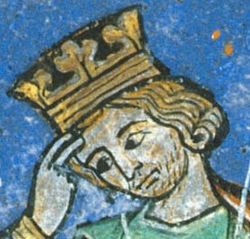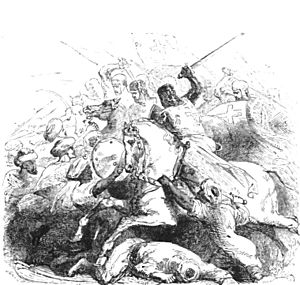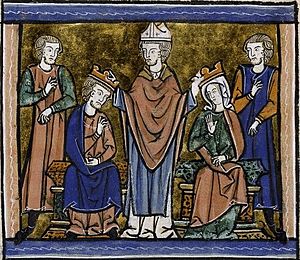Fulk, King of Jerusalem facts for kids

Fulk V (1092–1143), also known as "le Jeune" (the Younger), was an important French nobleman. He was the Count of Anjou from 1109 to 1129. He also became the Count of Maine from 1110 to 1129 through his marriage. Fulk was a crusader and a Knight Templar. Later, he became the King of Jerusalem from 1131 until he died.
Contents
Fulk's Early Life and Rise to Power
Fulk V was born in 1092. He was the younger son of Fulk IV le Réchin and his fifth wife, Bertrade de Montfort. As a baby, he likely grew up at the French royal court with his mother.
In 1106, Fulk's older brother, Geoffrey IV, Count of Anjou, died. King Philip I then made Fulk V the new Count of Anjou. Since Fulk was still young, the king asked Duke William of Aquitaine to be Fulk's guardian. However, the duke put Fulk in prison. Nothing the king or queen did could make the duke release him. After a year, Fulk's father paid a ransom to free his son. Fulk's father died two years later, in 1109. Fulk V then officially became the Count of Anjou.
Becoming Count of Maine
In 1110, Fulk V married Eremburge of Maine. A few months later, her father, Count Elias, died. This meant Fulk V became the Count of Maine because of his wife. This new title caused problems with King Henry I of England, who also wanted Maine.
In 1113, Henry I and Fulk V met to make peace. They agreed to a marriage alliance to seal their friendship. Fulk's young daughter, Matilda, was promised to Henry's nine-year-old son, William Adelin. Fulk V remained Count of Maine but promised to be loyal to King Henry I. This peace agreement also forced King Louis VI of France to make peace with Henry I.
Wars and Alliances
In 1116, King Louis VI of France attacked Normandy again. He supported Henry I's nephew, William Clito, as the Duke of Normandy. By 1117, King Louis IV, Count Baldwin VII of Flanders, and Fulk V were all supporting William Clito against Henry I.
The war began in the summer of 1118. Fulk V defeated Henry I in two battles. After these defeats, Henry I made peace with Fulk V. They confirmed the marriage of Fulk's daughter Matilda to Henry's son William Adelin. Fulk V gave Maine as a dowry for his daughter.
A Journey to the Holy Land
In 1120, Fulk V went on a pilgrimage to the Holy Land. He spent a year in Jerusalem. He even joined the Knights Templar, a group of warrior monks. When he returned to Anjou, Fulk left 100 knights behind to help defend the Kingdom of Jerusalem. He also continued to send money to the Templars every year for the rest of his life.

Fulk returned to Anjou in early 1121. He learned that his son-in-law, William Adelin, had drowned in the White Ship disaster. This meant the peace treaty with England was broken. Fulk's daughter Matilda was safe, as she had not been on the ship. Fulk asked for her return to Anjou. Henry delayed her return and kept part of her dowry. By 1122, Matilda was back in Anjou.
Fulk then broke off all ties with Henry I. He made another marriage alliance with Henry's enemy, William Clito. William was to marry Fulk's daughter Sibyl. Fulk again gave Maine as a dowry for his daughter. However, in 1124, Pope Callixtus II canceled the marriage between William Clito and Sibyl. This was because they were too closely related.
New Marriages and a Royal Offer
In 1126, Fulk's wife, Eremburge, died. Around the same time, Henry V, Holy Roman Emperor, died. His wife, the Empress Matilda, was King Henry I of England's only living child. Henry called her back to England. He made all his nobles promise that Matilda would become Queen of England if he had no sons.
In 1127, Henry I made peace with Fulk V again. He offered a new marriage alliance. Fulk's son, Geoffrey, was to marry the Empress Matilda. Maine would be given to the new couple. In June 1128, Henry I made Geoffrey of Anjou a knight. A week later, Geoffrey and Matilda were married.
Around this time, Fulk V received visitors from King Baldwin II of Jerusalem. King Baldwin II had no sons, only four daughters. He offered his oldest daughter, Melisende, to Fulk V. He also offered Fulk the crown of the Latin Kingdom of Jerusalem. Fulk was well-known in Jerusalem from his earlier visit and his yearly donations to the Knights Templar. In Jerusalem, Melisende was officially named the heir to the kingdom. She would rule as Queen when her father died.
After his son Geoffrey's wedding, Fulk V and his children met at the Fontevraud Abbey. His daughter Matilda became a nun there. Fulk said goodbye to his family and set off for Jerusalem. Geoffrey V, known as "la Bel," would rule Anjou in his father's absence.
In the spring of 1129, Fulk V arrived in Jerusalem. He and Melisende were married. Their marriage contract stated that when King Baldwin II died, Fulk and Melisende would rule Jerusalem together. As a dowry, Fulk and Melisende received two important ports: Tyre and Acre. Fulk also brought many knights and soldiers from Anjou with him.
King of Jerusalem

In 1131, King Baldwin II of Jerusalem died. Fulk and Melisende were crowned king and queen at the same time. However, Fulk tried to rule alone at first. He tried to keep Melisende from having an active role in governing Jerusalem. Fulk began replacing local leaders with his own followers from Anjou. This made many people in Jerusalem upset.
Between 1133 and 1134, a revolt began among the nobles of Jerusalem. It was led by Count Hugh II of Jaffa. Fulk ordered Hugh to appear before him, but Hugh refused. Fulk then took away Hugh's lands. Hugh was angry and joined with the Egyptian enemies. But his own followers left Hugh and returned to King Fulk. Hugh then gave up and was sent away for three years. The revolt ended. During this time, the Seljuks of Damascus took back Banyas. Fulk realized he could not rule without Melisende. From then on, he allowed her to share in ruling the kingdom.
In 1132, Pons, Count of Tripoli, was defeated by Seljuks and trapped in a castle. Fulk quickly went to help him and forced the enemy to leave. In 1134, Fulk attacked Hauran (in modern-day Syria and Jordan). But he had to retreat when the Seljuks attacked Jerusalem. In September, both sides agreed to a peace.
In 1136, Fulk began building castles around the city of Ascalon. This was to stop attacks on Jerusalem by the Egyptian Fatimids. He also built a castle at Beth Gibelin and gave it to the Knights Hospitaller to protect. Also in 1136, the leader of the Knights Templar died. Fulk used his influence to get one of his own men, Robert of Craon, elected as the new leader. In 1137, Fulk was trapped in a castle. The Patriarch of Jerusalem marched an army to rescue him. But Fulk did not know his army was coming. The Seljuks knew and offered Fulk good terms. King Fulk gave up the castle in exchange for his freedom.
In 1137, while Christians and Muslims were fighting, a new power arrived. John, the Byzantine Emperor, moved against Antioch. He decided to take the city back and began attacking its walls. Fulk was not strong enough to fight him. He decided to surrender Antioch to the Emperor. The Prince of Antioch, Raymond of Poitiers, had to surrender to the Emperor in person. Then, with the Byzantine flag flying over the city, the Emperor returned to Constantinople. Fulk, the King of Jerusalem, lost his control over Antioch.
On November 10, 1143, Fulk died in a hunting accident. He fell from his horse. After Fulk's death, Melisende took full control of Jerusalem. She ruled as queen and as a guardian for their oldest son, Baldwin III.
Family
In 1110, Fulk married Ermengarde of Maine (died 1126), the daughter of Elias I of Maine. They had:
- Geoffrey V (1113–1151), who became Count of Anjou after his father.
- Elias II (died 1151), who became Count of Maine after his father.
- Sibylla (1112–1165), who first married William Clito. She later married Thierry, Count of Flanders.
- Matilda (died 1154), who married William Adelin. After he died, she became a nun and later a leader at Fontevraud Abbey.
His second wife was Melisende, Queen of Jerusalem. She was the daughter of King Baldwin II of Jerusalem and Morphia of Melitene. Together they had:
- Baldwin III of Jerusalem, who became King of Jerusalem.
- Amalric I of Jerusalem, who also became King of Jerusalem.
See also
 In Spanish: Fulco de Jerusalén para niños
In Spanish: Fulco de Jerusalén para niños

